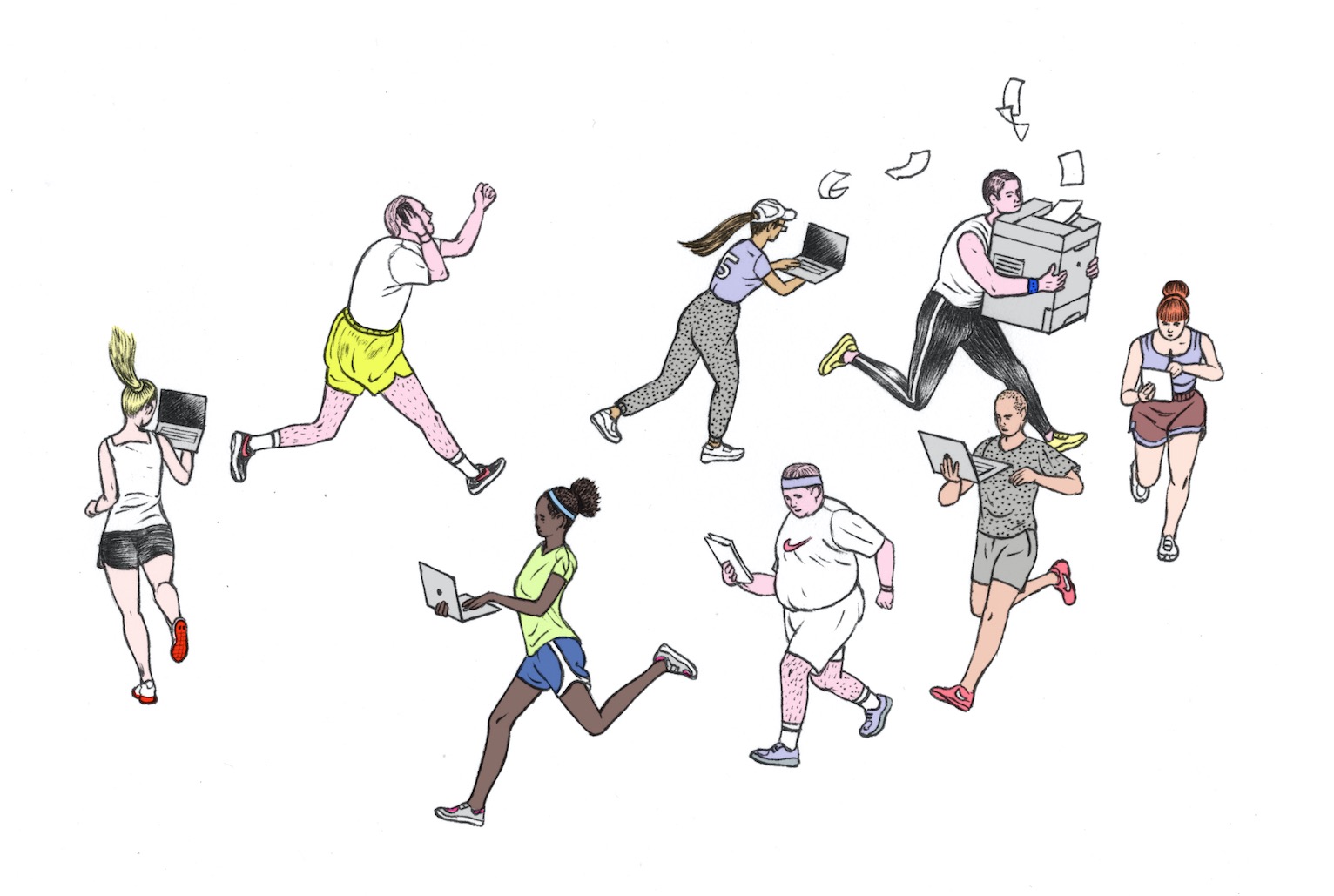Mind Your Business
In a post-recessionary world, where stress levels are rising, businesses are turning to a gentler kind of work culture. Welcome to the wellbeing workplace.

“As the Belgian philosopher Pascal Chabot put it, burnout is the disease of civilisation – the stress of over-busyness, overworking, overconnecting on social media, and underconnecting with ourselves and with one another,” says Arianna Huffington, founder of The Huffington Post and author of Thrive: The Third Metric to Redefining Success and Creating a Happier Life. “Nowhere is this more true than in the world of business. Our workplaces are dominated by language like killing it, crushing it, marching on and defeating our competitors, which immediately puts you in a permanent bellicose fight-or-flight state of mind.”
According to the World Health Organization, the stress this places on workers costs US businesses $300bn each year in healthcare and lost productivity, while the UK’s Chartered Institute of Personnel Development says that stress is a leading cause of absenteeism.
In an effort to prevent further stress problems, companies large and small are exploring wellness ideas previously considered the preserve of hippies and Californians. Meditation is increasingly visible in pop culture, with 50 Cent, Lena Dunham and Rupert Murdoch all tweeting about how it has helped them, while Evan Williams, the co-founder of Twitter, credits meditation in having helped him make major business decisions.
And the corporate giants have been listening. Major institutions ranging from Google and cereal giant General Mills to Transport for London and even the US Marine Corps are cherry-picking from meditation traditions to help their employees feel happier, calmer and more focused. The result is the burgeoning mindfulness movement. As Jon Kabat-Zinn, professor of medicine emeritus at the University of Massachusetts Medical School and the father of modern mindfulness, explains, “mindfulness means paying attention in a particular way; on purpose, in the present moment, and non-judgmentally.” In a practical sense, it means controlling your breathing, tuning out mental noise, listening more actively and focusing on the task at hand.
Sue Cartwright, professor of organisational behaviour and wellbeing at the University of Lancaster, says, “practising mindfulness has the potential to reduce stress, calm people down, make them more reflective, increase resilience and make people more aware of themselves and others.” Scientific research also suggests that mindfulness could have wider-ranging benefits, such as boosting the immune system and helping medical conditions, including type 2 diabetes, cardiovascular disease, asthma and chronic pain, and mental health issues such anxiety, insomnia and phobias.
General Mills, one of the first companies to explore the idea seriously, now has meditation rooms in every one of its buildings, where workers can attend mindfulness training or yoga classes. A survey of its senior staff found that after attending mindfulness sessions, 82% made time to eliminate tasks with limited productivity value; 80% reported better decision-making, and 89% said they had become better listeners. US insurance group Aetna reported similar results: a third of its 48,000 employees have attended wellbeing and mindfulness training, reporting reduced stress levels and greater awareness of stress triggers as a result. Transport for London’s programme saw a 71% drop in days taken off for stress, anxiety and depression among attendees.
It’s about being aware of where tech is helping and using it more. Turning off or not having the device doesn’t stop people thinking about it – if your smartphone is an integral part of life, use it to augment your behaviours Nathanael Wolfe, Mindfulness Daily
It’s not just industry titans pursuing workplace wellbeing – although, arguably, they have the most to gain from it. Medium, an online platform for writing set up by Twitter’s Williams, has built its entire ethos on mindfulness. The company uses mindfulness to boost the creativity and productivity of its team, and reduce the anxiety that often comes with startups. Medium’s team is visited three days a week by a meditation teacher, and holds an annual Medium mindfulness and meditation retreat, which 70% of its workers attend.
Mindfulness offers many personal benefits to workers and it certainly benefits employers too. Many offices are attempting to do the same amount of work as they achieved pre-recession, but with fewer staff. However, the resulting stress can be counterproductive, making workers distracted and unfocused. Mindfulness can keep them focused on necessary tasks. Mark Leonard, co-founder of The Mindfulness Exchange, says that we are distracted 47% of the time. “The more that’s going on and the more stressed we get, the more the mind is distracted. We end up daydreaming, planning or caught up in our worries. With mindfulness we can get more done by stopping what we’re doing for a few moments to refocus. We can reclaim some of the time lost to distraction.”
So, by reducing stress, increasing focus and wellbeing, it seems everybody wins. Huffington comments, “There is growing evidence that the long-term health of a company’s bottom line and the health of its employees are, in fact, very much aligned, and that when we treat them as separate, we pay a heavy price, both personally and collectively. Individually, we compromise our health and happiness. For businesses, the costs will be exacted in dollars and cents, talent retention, and diminished productivity.”
Strategic companies hope to head off those future costs and staff losses by improving worker wellbeing. Leigh Stringer, director of research and innovation at design firm HOK, says, “health, wellness and human performance are talked about synonymously by companies now. It sells the idea of wellness more easily if it can be tied to the bottom line.” For example, weekly yoga classes at General Mills decreased employee stress levels by a third and reduced healthcare costs by an average of $2,000 per person.
But there’s a limit to what in-office training can do, which is why wellness workplaces are now being pitched as a key employee benefit. “People are increasingly making snap decisions about jobs based on what the workplace is like, as well as the job itself,” says Whitney Gray, a member of the American Institute of Architects design and health leadership group. “The wellbeing workplace is being seen as part of a company’s benefits package – offering greater wellbeing to workers than its competitors.”

Wellbeing workplaces are not necessarily the over-the-top play spaces popularised by Google and myriad start-ups, full of gimmicks like slides and novelty furniture. The trick is to create an environment that supports wellbeing by reducing stressors so that people can work at peak functionality. These spaces offer plenty of natural light to balance workers’ circadian rhythms, incorporate state-of-the-art noise absorption techniques to reduce the irritations of other people, and introduce ways to get people out of their desks and get moving.
“The brain is more activated when the body is moving, so workplaces are being designed with motion in mind,” observes Stringer. Ergonomic workstations with sit-to-stand desks are fast becoming the norm, while at US health insurer Blue Cross Blue Shield’s Iowa headquarters, workers wear pedometers to encourage them to move about the space, and trackers on the walls show how many steps each team has taken in a day.
Mobile technology may have liberated people outside the workplace, but at the office, they’re stuck using mobile devices at workstations, so architects are creating spaces that allow people to move with their tech, whether in networked communal spaces or individual nooks for focused working. San Francisco architecture firm O+A, which works with Silicon Valley giants and startups alike, aims to create convivial spaces, such as staircases transformed into stadium- style seating by cushions, sculptural relaxation spaces screened by plants, and meeting places curtained with coloured plastic strips. Natural materials, shared tables and adaptable spaces are key in wellbeing workplaces, as municipal carpets, cubicle vistas and melamine desks are relegated to the past.
But what about the technology itself? Whether tech is mobile or static, there’s no denying that always-on culture and the constant pinging and buzzing of IM, email, texts and Tweets are contributing to workplace (and lifestyle) stresses. And yet the tech community is looking to digital tools to improve people’s wellbeing. Huffington says, “technology has been very good at giving us what we want, but not always what we need. So now, many in the tech world have realised there’s a growth opportunity for applications and tools that help us focus and filter all that data and distraction.”
Tools to help prevent online distraction include Anti-Social, which blocks social media sites while you’re trying to focus on work, SelfControl, which cuts access to distracting sites and even your mail server, and Freedom, which blocks online access entirely. Likewise, smartphones are becoming a key part of the mindfulness arsenal, with millions of people downloading apps such as GPS for the Soul, Headspace and Mindfulness Daily, which teach and track mindfullness throughout the day.
Nathanael Wolfe, co-founder of Mindfulness Daily, says, “it’s about being aware of where tech is helping and using it more. Turning off or not having the device doesn’t stop people thinking about it – if your smartphone is an integral part of life, use it to augment your behaviours.” One of the features of Mindfulness Daily is “device meditation”, which encourages users to incorporate the shape and sensations of the smartphone into their meditative process.
Wearables also have a part to play: while they are currently mostly focused on fitness and healthcare, usage in mindfulness will not be far behind. Design agency IDEO has worked with entrepreneurs Arye Barnehama and Laura Michelle Berman to develop Melon, a brain- monitoring headband that measures wearers’ brain activity during different activities and helps them learn how to improve their focus.
This kind of wearable technology may seem like the pinnacle of 2014-ness, but experts from across the spectrum are keen to point out that mindfulness is not simply a fad. Wellbeing at work is an adjustment that’s likely to become part of businesses’ bottom line in coming years, in the same way sustainability has. As the world of work becomes more complex and challenging, the need for mindfulness and wellbeing will not only increase, but will be woven into workplaces in a suitably subtle way. “Workplace wellness may not be newsworthy in a couple of years,” says Stringer, “but it will be part of the landscape.”


